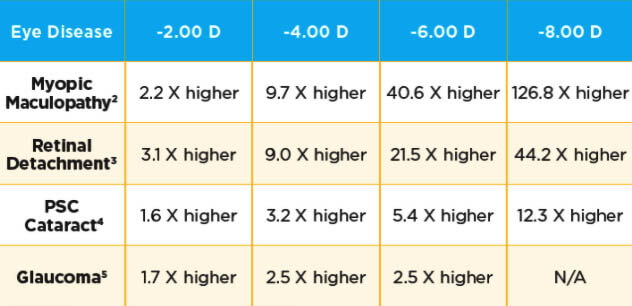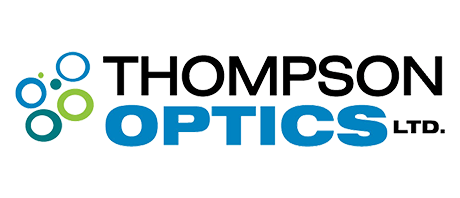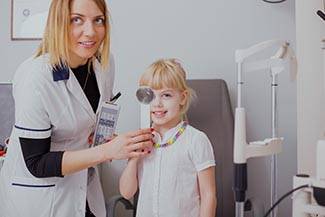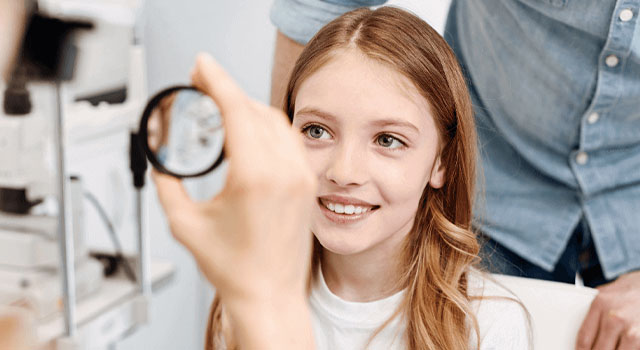Why Does Myopia Need to Be Managed?

Myopia (nearsightedness) is reaching epidemic proportions. By 2050, half of the world’s population is expected to have myopia. That’s worrying, as having myopia significantly raises the risk of developing sight-threatening eye diseases later in life, such as cataracts, glaucoma, retinal detachment and macular degeneration.
The level of myopia a child has is directly correlated to their risk of eye disease — the higher the myopia, the greater the risk. A child between -0.75D and -3.00 is more than 3 times more likely to develop retinal detachment in the future. That number triples for individuals with high myopia (-5.00 and above).
If you’re concerned that your child’s vision is deteriorating, contact Thompson Optics in Edmonton today. We can help.
Did You Know Myopia Is Caused By Abnormal Eye Growth?
Myopia is the most common refractive error among children and young adults. It occurs when the eye elongates, causing rays of light to focus in front of the light-sensitive retina rather than directly on it. This causes distant objects to appear blurred while nearby objects remain clear.
The degree of myopia can progress gradually or rapidly, especially from ages 8-18. This is not just a matter of inconvenience or needing stronger glasses; if the myopia continues to progress, the child is at a higher risk of developing dangerous eye diseases later in life that can lead to permanent vision loss and even blindness.
Although [eyeglasses] and standard contact lenses can correct a person’s vision, they do not treat the underlying cause of myopia or slow its progression.

Treatment Options for Myopia
There are three specific treatment options to slow the progression of myopia.
- Orthokeratology (Ortho-k)
Orthokeratology is one of the most effective forms of myopia control available today. Ortho-k works by employing specialty lenses that are worn at night and gently reshape the cornea (the round, clear area at the front of the eye) while you sleep. This has two main benefits: In the short-term, it corrects the refractive error responsible for myopia, meaning that when you wake up the morning after wearing ortho-k lenses, you should be able to see clearly without the need for contacts or glasses for the whole day. In the long term, ortho-k lenses have been shown to significantly reduce the rate of myopia progression.
- Atropine eye drops
Atropine eye drops are an effective method of myopia control that is often combined with other methods such as ortho-k, myopia control lenses and multifocal contacts. Though these drops are usually used in order to dilate the pupil and give your eye doctor a better view of the inside of your eye during eye exams, studies have also shown their effectiveness in myopia control. It’s thought that atropine drops of between 0.01% and 0.05% concentration slow the thinning or stretching of the sclera, thereby limiting the growth of the eye that is at the root of myopia progression.
- Multifocal contact lenses
The American Optometric Association (AOA) has found that multifocal contact lenses are even more effective than multifocal or bifocal glasses and equally as effective at ortho-k lenses when it comes to effective myopia management. It’s recommended that a child should wear their multifocal or bifocal contacts between 5 and 7 hours each day to begin experiencing benefits of myopia management. Though contact lenses are often considered a solution for older children, it is becoming increasingly common for elementary school children to wear them as well. As with all forms of myopia management, the earlier children begin treatment with multifocal contact lenses, the more effective their treatment, and the more likely their myopia progression can be slowed or prevented, and their sight can remain as clear as possible.
Our doctors work closely with each family and customize treatment programs for every child based on their unique needs. Patients are thoroughly evaluated, carefully monitored, and reviewed frequently in order to monitor progress and modify the treatment to ensure best outcomes. Follow-up visits generally occur every 6-12 months to assess the treatment’s efficacy.
Myopia vs Hyperopia
Myopia and hyperopia are two of the most common refractive vision errors. Though myopia and hyperopia do share some common symptoms, they are nonetheless distinct eye conditions with many differences. To understand these differences, let’s understand the conditions themselves.
What Is Myopia?
Myopia, also known as nearsightedness, occurs when the light entering the eye is refracted by the front of the eye so that it falls short of the retina, and focuses in front of it, causing images far off to become blurry, while closer objects usually remain in focus. This can happen for a number of reasons, but the most common is that the eyeball has grown too long.
What Is Hyperopia?
Hyperopia is better known as farsightedness. In many ways, it’s the opposite of myopia. Instead of being too long, the eyeball may be too short. This causes the light entering the eye to be refracted behind the retina, rather than in front of it as in myopia. Here too, the message received by the retina is incorrect and the patient’s vision is blurred. However, this time, it objects that are further away that are seen clearly, and those that are closer appear blurry.
Symptoms Of Myopia And Hyperopia
Despite being different conditions, myopia and hyperopia do have some symptoms in common. These include:
- Squinting
- Eye discomfort including burning and irritation
- Headaches
- Eye fatigue
- Blurry vision (though at different distances)
Symptoms of myopia can present at any age, usually beginning in childhood, whereas hyperopia is usually a condition a person has from birth. Both tend to be hereditary, meaning they are passed down from generation to generation.
Treating Myopia And Hyperopia
Prescription glasses or contact lenses are the most common and successful treatment for myopia and hyperopia. These work by changing the way that light is refracted by the eye, so that it reaches the retina properly, producing clear vision.
High Myopia
Myopia, also known as nearsightedness, is an eye condition in which you can see nearby objects clearly, but objects in the distance appear blurry. This can occur for many reasons, but the most common reasons are your eyeball is too long or the curve of your cornea or lens is irregular. As a consequence, light rays entering your eye are bent incorrectly, focusing images in front of your retina, instead of on it, resulting in blurry vision.
High myopia is usually defined as nearsightedness that requires a corrective prescription of -6.00 or stronger. It often occurs in people whose eyes are very long, and most commonly begins showing symptoms in early childhood. The earlier the onset of myopia, the higher the likelihood it will later advance to high myopia
Though it is commonly associated with early childhood, visual stress or diabetes can also cause high myopia to develop during adulthood. Eye doctors can treat high myopia with prescription glasses, contact lenses, or laser surgery. However, it’s important to note that laser surgery is not an option for children.
High myopia significantly increases your risk of severe vision problems later in life such as retinal detachment, vitreous floaters, cataracts, and glaucoma. Regular visits to your eye doctor can help you detect and treat any complications early, maximizing the chances of preventing later vision loss.
Hypermetropia
Hypermetropia, also known as hyperopia or farsightedness, is a common vision disorder in which vision is blurry when looking at objects close-up, but gets progressively clearer as objects get further away. It results from the overall power of the eye not being strong enough, or the length of the eye being too short.
This causes the rays of light that enter the eye to focus on a point behind the retina rather than on the retina itself to focus.
Hypermetropia can occur at any age. It is very common for children to have small degrees of hypermetropia which they may grow out of over time as they grow older and their eyes grow longer.
Myopia Glasses
Myopia, or nearsightedness, is common in both adults and children, which typically begins showing symptoms in childhood.
It occurs when the eyes grow slightly too long or the lens of your eye is more curved than usual. This causes the light that enters your eye to focus just in front of the retina, rather than on it, making distant objects appear blurry, while nearby objects remain in focus.
Wearing glasses for myopia is a common and effective solution. During the course of a routine comprehensive eye exam, our local Edmonton eye care team will be able to determine your lens prescription in order to address your myopia and deliver the clear vision.
Glasses for myopia help because they allow the light to reflect on the correct part of the retina. Lenses for these glasses are often concave (curved inwards), which moves the focus of the light further back, so that it reaches the retina properly, resulting in clear vision.
What Causes Myopia
Nearsightedness (myopia) is a common vision condition in which you can see objects nearby clearly, but objects farther away are blurry. It may develop gradually or rapidly, often worsening during childhood and adolescence. Nearsightedness tends to run in families.
Your eye has two parts that focus on images. These are the cornea and the lens. A healthy eye will be roughly round, and the lens and cornea will be curved and smooth like the surface of a marble. The cornea and lens are then meant to bend or refract all light entering the eye to make a sharply focused image directly on the retina, at the back of your eye.
However, if your eye is too long or the cornea or lens is not curved properly or isn’t fully smooth, light may be refracted incorrectly. This can cause the light to be focused too far forward in the eye, making it blurry by the time it reaches the retina.
Risk factors commonly considered to be linked to myopia include genetic and environmental factors. Children with parents that have myopia are likely to develop it themselves. Some studies also suggest that increased time spent on near-work tasks such as reading and writing, paired with decreased time spent outdoors, may contribute to the development and progression of myopia.
Astigmatism vs Myopia
Myopia, nearsightedness and astigmatism are both common refractive errors that cause blurry vision. While myopia causes blurry vision when viewing objects from far away, astigmatism causes blurriness from any distance. The causes and symptoms of both of these conditions are also different. Understanding both conditions more deeply may help illustrate their differences.
Myopia and its symptoms
Myopia, or nearsightedness, affects your ability to clearly see objects at a distance. It occurs when the eye is too long, causing light to focus too far forward in the eye, causing it to be blurred when it reaches the retina at the back of the eye. A person with myopia will tend to be able to see objects close-up clearly, while further away objects will appear blurry.
Myopia most commonly begins in childhood, though it can also occur later in life in rare circumstances.
Common symptoms of myopia may include:
- Squinting to bring far away objects into focus
- Blurred vision at long distance
- Headaches
Astigmatism and its symptoms
Astigmatism is caused by an imperfection in the cornea or lens of your eye that causes light entering the eye to be scattered as it reaches the retina. Two main types of astigmatism exist; corneal and lenticular astigmatism. Both types can affect anyone, at any age.
Common symptoms of astigmatism may include:
- Double vision
- Blurry vision both close up and far away
- Red eyes
As you can see from the above information, key differences between myopia and astigmatism include:
- Myopia occurs as a result of the eye being too long. While astigmatism results from the cornea or lens of the eye not being perfectly smooth or round, causing poor vision.
- Myopia causes light entering the eye to be focused in front of the retina resulting in poor vision at a distance. In astigmatism, light is scattered, causing it to focus on multiple spots on the retina, and blurring vision both close up and far away.
- Myopia usually develops between the ages of 8 to 14 years and can stabilize around 15 to 21 years old. Astigmatism on the other hand can happen at any age.

What Parents Are Saying About Myopia Management
Myopia increases the risk of serious, sight threatening complications.

How Do I Know If My Child Needs Myopia Management?
If you are concerned about your child’s myopia, call our practice today. Our team of eye care professionals will help you understand more about your child's nearsightedness and will determine whether your child is a candidate for myopia management.
Take our myopia assessment online to find out whether your child could benefit from this life-changing treatment.
Myopia Management Offers a Brighter Future | FAQ
If you’ve been wearing glasses or contacts for many years without much concern, it may seem unnecessary to manage your child’s myopia. However, it’s a worthwhile and important investment, as rapidly progressing myopia may lead to more severe eye complications and sight-threatening conditions, such as cataracts, glaucoma, macular degeneration and retinal detachment.
In fact, the longer the eyeball length, the greater the risk of ocular complications down the line.
Myopia management has been shown to effectively help reduce the rate of growth of the eyeball in children and teens by slowing its progression. Offer your child a brighter future with myopia management.














